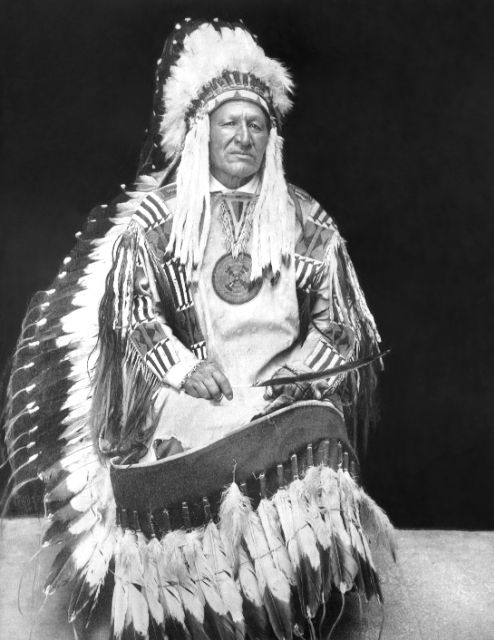Chief Charging bear
Photo ©Rick Sheremeta

Charging Bear, whose Lakota name was Matowatakpe, was a prominent figure in Lakota Sioux history and a respected leader among his people. Born in the mid-19th century, Chief John Grass, as he is commonly known, played a significant role in the resistance against the encroachment of European settlers and the U.S. government onto Lakota lands in the late 1800s.
Charging Bear was born into the Hunkpapa Lakota Sioux tribe, known for their warrior tradition and strong cultural heritage. He grew up on the Great Plains, where he learned the traditional ways of his people, including hunting, fishing, and horse riding. He also gained a reputation as a skilled and courageous warrior, earning the respect of his fellow tribe members.
As a young man, Charging Bear became involved in the resistance movement against the increasing presence of white settlers in Lakota territory. He joined the legendary Lakota leader Sitting Bull in his efforts to protect Lakota lands and way of life. Charging Bear quickly rose through the ranks and became one of Sitting Bull’s trusted advisors and warriors.
During the 1870s, Charging Bear played a crucial role in several battles against the U.S. Army, including the famous Battle of the Little Bighorn in 1876. He fought bravely alongside Sitting Bull and other Lakota leaders, defending their ancestral lands against the encroachment of the U.S. government and its military forces.
After the defeat of General George Custer and the U.S. Army at the Battle of the Little Bighorn, Charging Bear’s reputation as a formidable warrior grew even stronger. He became known for his strategic skills and his unwavering commitment to protecting Lakota lands and culture. His leadership qualities and wisdom earned him the respect and admiration of his fellow tribe members, and he was soon recognized as one of the most influential leaders among the Lakota Sioux.
In addition to his military prowess, Charging Bear was also known for his diplomacy and peacemaking efforts. He sought to maintain peaceful relations with neighboring tribes and attempted to negotiate with the U.S. government on behalf of his people. However, as the U.S. government continued to pursue a policy of land seizure and forced assimilation of Native Americans, Charging Bear and his fellow Lakota leaders found it increasingly difficult to protect their lands and way of life.
In 1889, the U.S. government passed the Dawes Act, which aimed to break up Native American reservations and allot lands to individual Native Americans. This policy further threatened Lakota lands and culture, and Charging Bear became even more determined to resist these oppressive measures. He continued to advocate for the rights of his people and fought against the unjust treatment of Native Americans by the U.S. government.
Despite his efforts, Charging Bear and his people eventually faced significant challenges. The U.S. government continued to exert pressure on the Lakota Sioux, and their traditional way of life was increasingly threatened. Many Lakota were forced onto reservations, where they faced poverty, disease, and cultural suppression.
In the face of these challenges, Charging Bear remained steadfast in his commitment to his people. He continued to speak out against the injustices faced by Native Americans and worked tirelessly to protect their lands and culture. His leadership and unwavering determination earned him the respect and admiration of not only the Lakota Sioux but also of other Native American tribes and individuals who sought to resist the oppressive policies of the U.S. government.
Charging Bear’s legacy as a leader and warrior continues to be celebrated by the Lakota Sioux and Native American communities to this day. His courage, wisdom, and commitment to his people’s rights and culture make him a revered figure in Lakota history and a symbol of resilience in the face of adversity.
